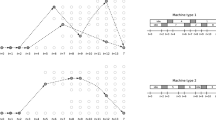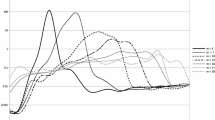Abstract
For the basic problem of scheduling a set of n independent jobs on a set of m identical parallel machines with the objective of maximizing the minimum machine completion time—also referred to as machine covering—we propose a new exact branch-and-bound algorithm. Its most distinctive components are a different symmetry-breaking solution representation, enhanced lower and upper bounds, and effective novel dominance criteria derived from structural patterns of optimal schedules. Results of a comprehensive computational study conducted on benchmark instances attest to the effectiveness of our approach, particularly for small ratios of n to m.


Similar content being viewed by others
References
Ahuja, R. K., & Orlin, J. B. (2001). Inverse optimization. Operations Research, 49, 771–783.
Alvim, A. C. F., Ribeiro, C. C., Glover, F., & Aloise, D. J. (2004). A hybrid improvement heuristic for the one-dimensional bin packing problem. Journal of Heuristics, 10, 205–229.
Azar, Y., & Epstein, L. (1998). On-line machine covering. Journal of Scheduling, 1, 67–77.
Brucker, P., & Shakhlevich, N. V. (2009). Inverse scheduling with maximum lateness objective. Journal of Scheduling, 12, 475–488.
Brucker, P., & Shakhlevich, N. V. (2011). Inverse scheduling: Two-machine flow-shop problem. Journal of Scheduling, 14, 239–256.
Cai, S.-Y. (2007). Semi-online machine covering. Asia-Pacific Journal of Operational Research, 24, 373–382.
Csirik, J., Kellerer, H., & Woeginger, G. (1992). The exact LPT-bound for maximizing the minimum completion time. Operations Research Letters, 11, 281–287.
Dell’Amico, M., & Martello, S. (1995). Optimal scheduling of tasks on identical parallel processors. ORSA Journal on Computing, 7, 191–200.
Deuermeyer, B. L., Friesen, D. K., & Langston, M. A. (1982). Scheduling to maximize the minimum processor finish time in a multiprocessor system. SIAM Journal on Algebraic and Discrete Methods, 3, 190–196.
Ebenlendr, T., Noga, J., Sgall, J., & Woeginger, G. (2006). A note on semi-online machine covering. In T. Erlebach & G. Persiano (Eds.), Approximation and online algorithms. Lecture Notes in Computer Science (Vol. 3879, pp. 110–118). Berlin: Springer.
Epstein, L., Levin, A., & van Stee, R. (2011). Max-min online allocations with a reordering buffer. SIAM Journal on Discrete Mathematics, 25, 1230–1250.
França, P. M., Gendreau, M., Laporte, G., & Müller, F. M. (1994). A composite heuristic for the identical parallel machine scheduling problem with minimum makespan objective. Computers & Operations Research, 21, 205–210.
Frangioni, A., Necciari, E., & Scutellà, M. G. (2004). A multi-exchange neighborhood for minimum makespan parallel machine scheduling problems. Journal of Combinatorial Optimization, 8, 195–220.
Friesen, D. K., & Deuermeyer, B. L. (1981). Analysis of greedy solutions for a replacement part sequencing problem. Mathematics of Operations Research, 6, 74–87.
Graham, R. L. (1969). Bounds on multiprocessing timing anomalies. SIAM Journal on Applied Mathematics, 17, 416–429.
Graham, R. L., Lawler, E. L., Lenstra, J. K., & Rinnooy Kan, A. H. G. (1979). Optimization and approximation in deterministic sequencing and scheduling: A survey. Annals of Discrete Mathematics, 5, 287–326.
Haouari, M., & Jemmali, M. (2008). Maximizing the minimum completion time on parallel machines. 4OR: A Quarterly Journal of Operations Research, 6, 375–392.
He, Y., & Tan, Z. Y. (2002). Ordinal on-line scheduling for maximizing the minimum machine completion time. Journal of Combinatorial Optimization, 6, 199–206.
Heuberger, C. (2004). Inverse combinatorial optimization: A survey on problems, methods, and results. Journal of Combinatorial Optimization, 8, 329–361.
Koulamas, C. (2005). Inverse scheduling with controllable job parameters. International Journal of Services and Operations Management, 1, 35–43.
Labbé, M., Laporte, G., & Martello, S. (1995). An exact algorithm for the dual bin packing problem. Operations Research Letters, 17, 9–18.
Luo, R.-Z., & Sun, S.-J. (2005). Semi on-line scheduling problem for maximizing the minimum machine completion time on \(m\) identical machines. Journal of Shanghai University, 9, 99–102.
Peeters, M., & Degraeve, Z. (2006). Branch-and-price algorithms for the dual bin packing and maximum cardinality bin packing problem. European Journal of Operational Research, 170, 416–439.
Tan, Z., & Wu, Y. (2007). Optimal semi-online algorithms for machine covering. Theoretical Computer Science, 372, 69–80.
Walter, R. (2013). Comparing the minimum completion times of two longest-first scheduling-heuristics. Central European Journal of Operations Research, 21, 125–139.
Walter, R., & Lawrinenko, A. (2014). Effective solution space limitation for the identical parallel machine scheduling problem. Working Paper. http://s.fhg.de/WrkngPprRW.
Woeginger, G. J. (1997). A polynomial-time approximation scheme for maximizing the minimum machine completion time. Operations Research Letters, 20, 149–154.
Author information
Authors and Affiliations
Corresponding author
Appendix: Detailed results on benchmark instances
Appendix: Detailed results on benchmark instances
Tables 7 and 8 contain detailed results for each of the 390 uniform and 390 non-uniform benchmark instances, respectively. Each row corresponds to a triple (n, m, Interval) and each column to one of the 10 instances per triple. For each instance, we record the best found objective function value (labeled as “Best”) as well as the best found upper bound value (labeled as “UB”). Bold entries indicate optimal values.
Rights and permissions
About this article
Cite this article
Walter, R., Wirth, M. & Lawrinenko, A. Improved approaches to the exact solution of the machine covering problem. J Sched 20, 147–164 (2017). https://doi.org/10.1007/s10951-016-0477-x
Published:
Issue Date:
DOI: https://doi.org/10.1007/s10951-016-0477-x




